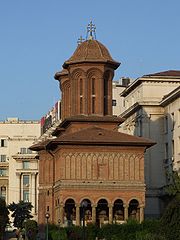
Kretzulescu Church
Encyclopedia

Bucharest
Bucharest is the capital municipality, cultural, industrial, and financial centre of Romania. It is the largest city in Romania, located in the southeast of the country, at , and lies on the banks of the Dâmbovița River....
, Romania
Romania
Romania is a country located at the crossroads of Central and Southeastern Europe, on the Lower Danube, within and outside the Carpathian arch, bordering on the Black Sea...
. Built in the Brâncovenesc style
Brâncovenesc style
Is a type of architecture developed in Wallachia during the reign of Constantin Brâncoveanu in the 17th and 18th century.Examples of buildings with this style:*Horezu Monastery*Văcăreşti Monastery**Brâncoveanu Monastery*Surpatele Monastery...
, it is located on Calea Victoriei
Calea Victoriei
Calea Victoriei is a major avenue in central Bucharest. It leads from Splaiul Independenţei to the north and then northwest up to Piaţa Victoriei, where Şoseaua Kiseleff continues north....
, nr. 45A, at one of the corners of Revolution Square
Revolution Square, Bucharest
Revolution Square is a square in central Bucharest, on Calea Victoriei. Known as Piaţa Palatului until 1989, it was later renamed after the 1989 Romanian Revolution....
, next to the former Royal Palace
National Museum of Art of Romania
The National Museum of Art of Romania is located in the former royal palace in Revolution Square, central Bucharest, Romania, completed in 1937...
.
The church was commissioned in 1720–1722 by the boyar
Boyar
A boyar, or bolyar , was a member of the highest rank of the feudal Moscovian, Kievan Rus'ian, Bulgarian, Wallachian, and Moldavian aristocracies, second only to the ruling princes , from the 10th century through the 17th century....
Iordache Creţulescu and his wife Safta, a daughter of prince Constantin Brâncoveanu
Constantin Brâncoveanu
Constantin Brâncoveanu was Prince of Wallachia between 1688 and 1714.-Ascension:A descendant of the Craioveşti boyar family and related to Matei Basarab, Brâncoveanu was born at the estate of Brâncoveni and raised in the house of his uncle, stolnic Constantin Cantacuzino...
. Originally, the exterior was painted, but since the restoration work done in 1935–1936 (under the supervision of architect Ştefan Balş), the facade
Facade
A facade or façade is generally one exterior side of a building, usually, but not always, the front. The word comes from the French language, literally meaning "frontage" or "face"....
is made of brick
Brick
A brick is a block of ceramic material used in masonry construction, usually laid using various kinds of mortar. It has been regarded as one of the longest lasting and strongest building materials used throughout history.-History:...
. The fresco
Fresco
Fresco is any of several related mural painting types, executed on plaster on walls or ceilings. The word fresco comes from the Greek word affresca which derives from the Latin word for "fresh". Frescoes first developed in the ancient world and continued to be popular through the Renaissance...
es on the porch date from the original structure, while the interior frescoes were painted by Gheorghe Tattarescu
Gheorghe Tattarescu
Gheorghe Tattarescu was a Moldavian-born Romanian painter and a pioneer of neoclassicism in his country's modern painting.-Early life and studies:...
in 1859–1860.
The church, damaged during the November, 1940 earthquake, was repaired in 1942–1943. In the early days of the communist regime
Communist Romania
Communist Romania was the period in Romanian history when that country was a Soviet-aligned communist state in the Eastern Bloc, with the dominant role of Romanian Communist Party enshrined in its successive constitutions...
, Kretzulescu Church was slated for demolition, but was saved due to efforts of architects such as Henriette Delavrancea-Gibory. More renovations took place after the Bucharest earthquake of 1977
1977 Bucharest Earthquake
The 1977 Vrancea Earthquake occurred on Friday, 4 March 1977, 21:20 local time and was felt throughout the Balkans. It had a magnitude of 7.2 with an epicenter in Vrancea at a depth of ....
and the Revolution of 1989
Romanian Revolution of 1989
The Romanian Revolution of 1989 was a series of riots and clashes in December 1989. These were part of the Revolutions of 1989 that occurred in several Warsaw Pact countries...
. To the side of the church now stands a memorial bust of Corneliu Coposu
Corneliu Coposu
-Early life:Coposu was born in Bobota, Sălaj County to the Romanian Greek-Catholic archpriest Valentin Coposu and his wife Aurelia Coposu...
.

